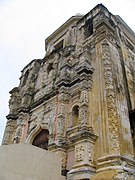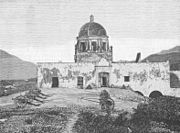Palacio Del Obispado
It is located on the top of the Chepa Verde hill, which got its name due to it being surrounded by the lands of José Vera. The Palace was constructed on the slopes of the hill, now named Cerro del Obispado (Bishop Hill) after its principal building.
The building has also served as a military fortress and a public walkway. Since September 20th, 1956, it has hosted the Regional Museum of Leon.
History
During the reign of Charles III of Spain and through a bull issued by Pope Pious VI in 1777, the Diocese of Linares was erected for the town of the same name.
At the request of the king, the Pope named the palace the diocese of Antonio de Jesús Sacedón, who received his assignment in 1779 through a representative who took possession of the building with all its rites. He died before arriving at Linares and the Pope named Rafael José Verger as his successor.
As soon as he received his assignment, he requested the Pope move the Bishop's capital to Monterrey, the only population he deemed worthy of it.
Construction and Restoration
The property was constructed at the end of the Viceroyalty at the request of the Franciscan Friar Rafael José Verger, whom promoted the construction of a House of Repose and Worship on lands that were conceded by the city hall of Monterey in 1787.

After the death of Friar Rafael José Verger and Mexico's independence, the palace has been used as a military fortress, having a prominent role in the defense of the city during the battle of Monterrey in the Mexican-American War (1846), the Second French intervention in Mexico (1864), the Plan de la Noria (1871), and the Mexican Revolution (1913 & 1914).
Towards the end of the 19th century, an agreement was signed between the Federal Government of Mexico and the State of Nuevo León in which the Federal Government remained in possession of the building, but passed approximately 30 hectares of surrounding lands of the hill and its slopes into State possession.
The palace, however, suffered some damages and modifications and spent decades abandoned and in ruin, being used as a lazaretto during the epidemics of 1893 and 1903, and as a cabaret in 1920.
This structure, now commonly known as the Obispado, has a large historical and architectural value. The first restoration was started in 1946 and ten years later, in 1956, it was incorporated as a museum. Until 1998, they recovered the corriders of the main building and decorated the interior of the oratory dome.
Architecture
The Bishop's Palace was built in the Spanish colonial Baroque style. The domed tower has a carved stone facade.

It is one of the city's oldest buildings, completed by the end of the 18th century.
The palace is distinguished by its large size, as well as the solidity and height of its walls. The size of its main facade in its Baroque style and its stipe (inverted copyramidal column or pillar) highlights the grandeur of its dome, completed in 1853 and 1857.
The building is built of ashlar stone, a characteristic material of the region, and is one of the few examples of viceregal architecture that are still preserved in northeastern Mexico.
Gallery
See also
References
- ^ "Museo Regional de Nuevo León (Del Obispado)". www.mexicoescultura.com (in Spanish). Retrieved 2024-02-09.
- ^ Delgado-García, G. R., Estañol-Vidal, B., Villarreal-Alarcón, M. Á., & Galarza-Delgado, D. Á. (2013). La Orden Imperial de Guadalupe en Monterrey: el caso de José Eleuterio González. Medicina Universitaria (In Spanish), 15(61), 193-196.
- ^ Tapia, Aureliano (1979). "LA CREACIÓN DEL PRIMITIVO OBISPADO DE LINARES". Humanitas Digital (in Spanish) (20): 283–301. ISSN 2007-1620.
- ^ Mora, J. A. (1982). En el XXV aniversario del museo. https://cd.dgb.uanl.mx/bitstream/handle/201504211/6274/9269.pdf?sequence=1. Retrieved February 9th, 2024.



